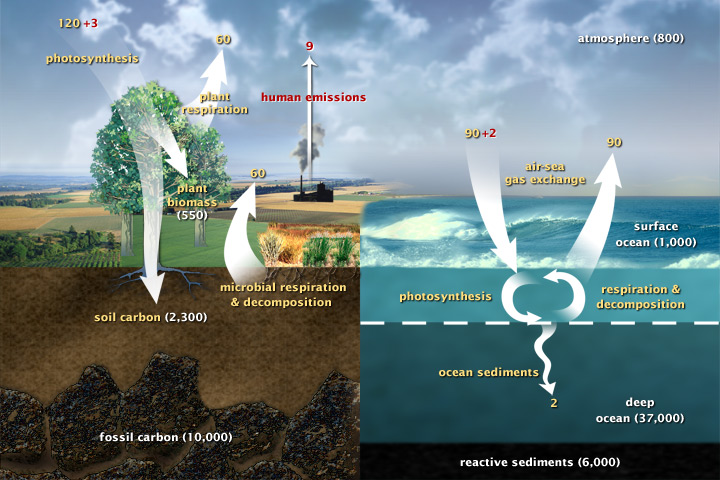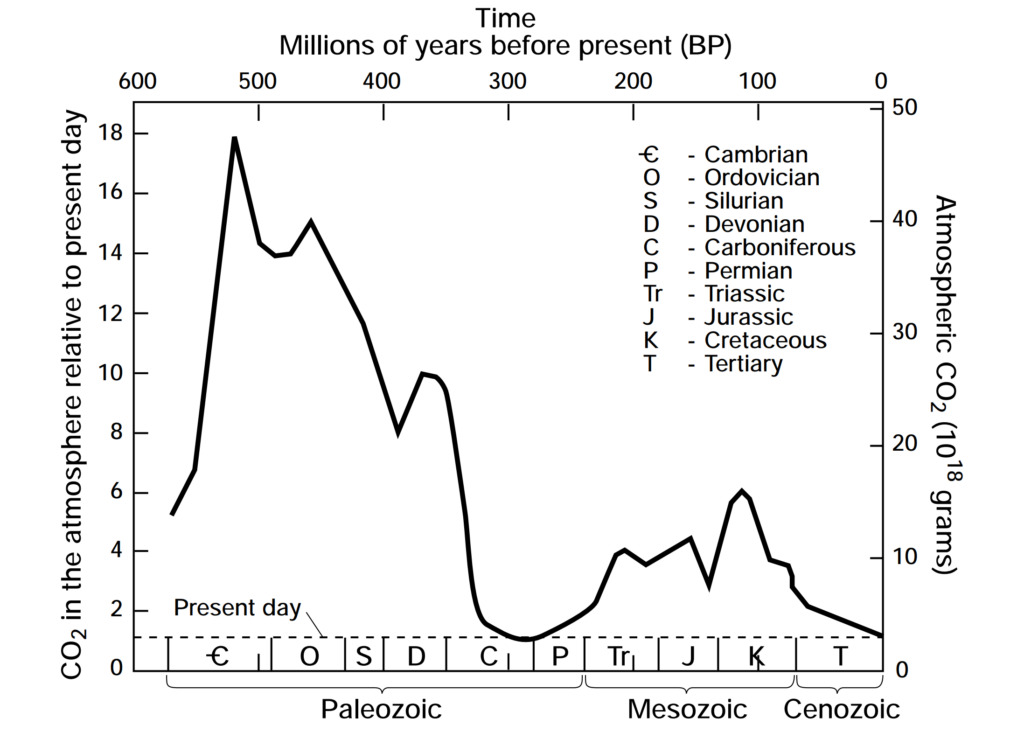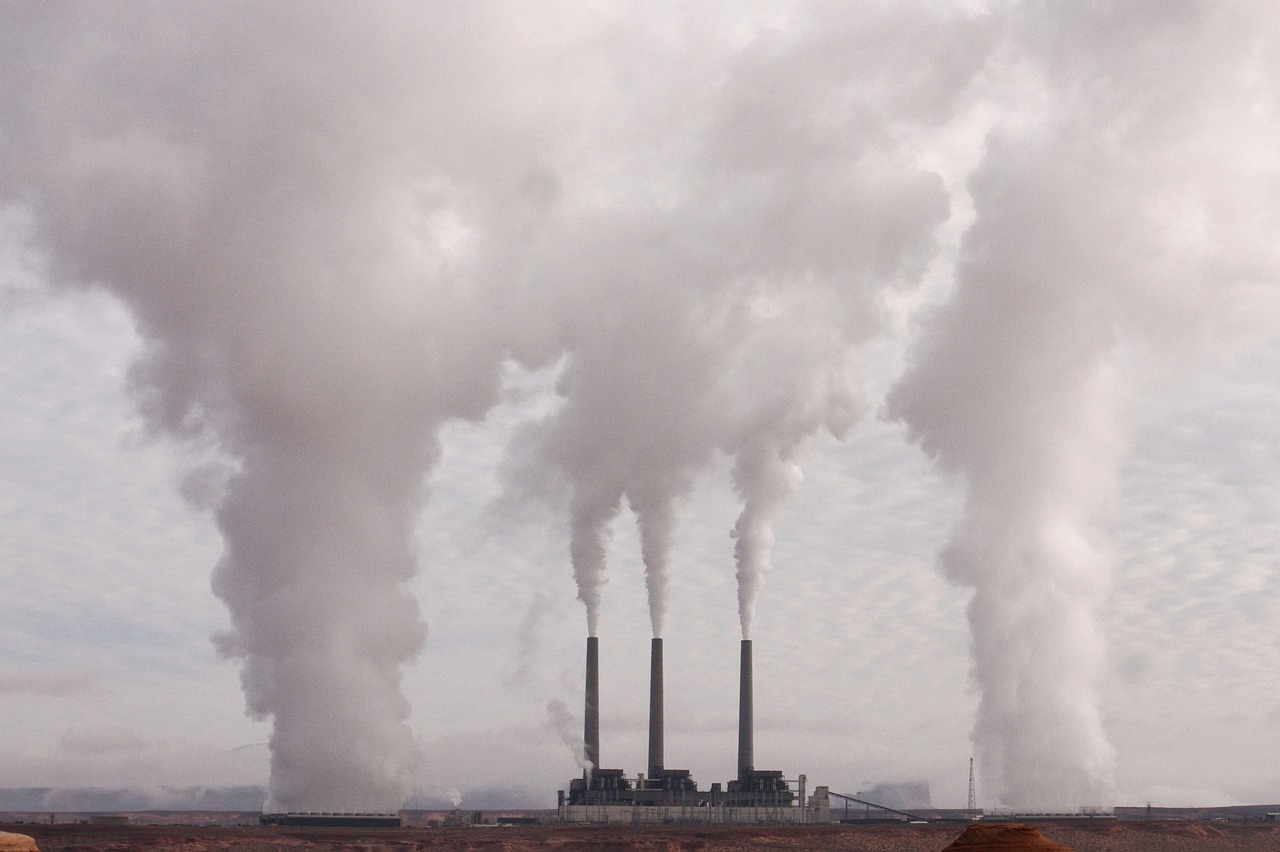- CO2 is a part of the planet’s natural processes, and has existed in much greater concentrations in the far distant past
- The relationship between CO2 increase and temperature increase works both ways
- There is robust evidence that most of the observed increase in atmospheric CO2 is manmade
CO2 emissions are caused by the burning of any hydrocarbon fuel, from wood, through to coal oil and gas. The elimination of combustion of fossil fuels is the primary aim of both national and global policy. The mainstream belief is that manmade (anthropogenic) CO2 emissions explain the build of the gas in the atmosphere.
However, CO2 is also a natural product of biology and of natural processes such as wildfire. And the ‘carbon cycle‘ is seen as part of the planet’s ecosystem, as the following diagram from NASA demonstrates.

According to this carbon cycle model, there are both natural sources of CO2 and ‘carbon sinks’, which sequester atmospheric CO2. For example, plants consume CO2, and with the help of sunlight, convert the CO2 into oxygen, which the plant re-emits into the atmosphere and carbon, which the plant uses to build itself. however, most photosynthesis occurs in the oceans, not on land.
The mainstream view is that anthropogenic CO2 emissions overwhelm the capacity of natural processes to remove CO2 from the atmosphere — hence the increased concentration of atmospheric CO2. But a number of hypotheses have challenged this view.
CO2 lags temperature
In An inconvenient Truth, Al Gore showed the relationship between historic temperatures and atmospheric CO2 concentrations.
But closer observation of historical reconstructions of temperature and atmospheric CO2 concentrations shows that temperature rise seems to precede CO2 increase by some 800 years.
This is caused by ‘outgassing’. As soils and oceans warm, they are able to hold less CO2 (and other gases), and so release it into the atmosphere. Some sceptics argue that therefore warming may be natural (caused by things other than human activity, such as the factors that cause ice ages), and changes in atmospheric CO2 concentration are the natural response, and that CO2 plays a minor role in the planet’s temperature. This gives rise to the question whether CO2 concentration really drives global temperature, or temperature drives CO2.
The answer may be both. Some climate scientists who hold with the theory that CO2 is the main driver of the world’s current temperature rise also argue that outgassing is a ‘positive feedback‘ mechanism, which can multiply the warming effect, making the world more sensitive to CO2 emissions. They argue that there is a difference between the processes observed at geological timescales, as depicted by Al Gore’s chart, to the current warming that the world is experiencing — in decades rather than centuries.
From an objective standpoint, while there may be merits to both perspectives, a good faith debate on this issue is confounded by the intense political polarisation that precedes differences of opinion on scientific claims. More research is likely needed to understand the processes at geological and climate timescales. But with so much required of science to support political outcomes, scientists may be put off such lines of research, either because it may be a personal risk to them, or because such an investigation may not suit scientific institutions’ research agenda.
Other sources of CO2 are underestimated
Some scientists argue that whereas the mainstream view is that the majority of seemingly excess CO2 in the atmosphere is anthropogenic (manmade), the contribution of natural sources of greenhouse gases may have been underestimated. Professor Ian Plimer, for example, suggests that the role of undersea volcanoes, which are remote, have yet to be discovered.
But mainstream critics point out that this hypothesis lacks a concrete basis. Rebuttals argue that the observable anthropogenic contribution to atmospheric CO2 are vastly greater than the contribution from volcanic activity:
The projected 2010 anthropogenic CO2 emission rate of 35 gigatons per year is 135 times greater than the 0.26-gigaton-per-year preferred estimate for volcanoes.
Plimer has not helped the characterisation of his claims, arguing that,
Over the past 250 years, humans have added just one part of CO2 in 10,000 to the atmosphere. One volcanic cough can do this in a day
One part in 10,000 is roughly the difference between preindustrial and present day atmospheric CO2 cincentrations — from 300 parts per million (ppm) to 400 ppm. Here, Plimer is choosing to emphasise the absolute concentration of CO2 in the atmosphere rather than its relative increase, but volcanic events of the magnitude that could produce such a change in the atmosphere ‘in one day’ are extremely rare relative to human and climate timescales. As the following chart of CO2 concentrations shows, there appears not to have been such an event during the past 800,000 years, and very recent anthropogenic CO2 seems to be dominant.
The volcanic influence that Plimer describes likely occurred far further into the planet’s history, as the following chart [source] indicates.

This chart also shows that at geological timescales, the Earth is currently experiencing historically low CO2 concentrations. And this is the timescale that drives Plimer’s claim. Writing in 2009, Plimer added more to this view in a response to the vitriol he believed characterised climate politics, though without explaining how natural sources explain the current rise in CO2.
The original source of atmospheric CO2 is volcanoes. The Earth’s early atmosphere had a thousand times the CO2 of today’s atmosphere. This CO2 was recycled through rocks, life and the oceans.
Through time, this CO2 has been sequestered into plants, coal, petroleum, minerals and carbonate rocks, resulting in a decrease in atmospheric CO2.
The atmosphere now contains 800 billion tonnes of carbon as CO2. Soils and plants contain 2000 billion tonnes, oceans 39,000 billion tonnes and limestone 65,000,000 billion tonnes. The atmosphere contains only 0.001 per cent of the total carbon in the top few kilometres of the Earth.
Deeper in Earth, there are huge volumes of CO2 yet to be leaked into the atmosphere. So depleted is the atmosphere in CO2, that horticulturalists pump warm CO2 into glasshouses to accelerate plant growth.
The first 50 parts per million of CO2 operates as a powerful greenhouse gas. After that, CO2 has done its job, which is why there has been no runaway greenhouse in the past when CO2 was far higher.
Note that Plimer’s explanation is that volcanoes are the original source of carbon in the carbon cycle, though not the major input, in terms of changes between the atmosphere and its other parts. While this observation defeats claims that ‘runaway global warming’ is plausible (Plimer’s point about the saturation of atmospheric CO2 is discussed in our article on the properties of greenhouse gases) it does make the case that inputs from volcanoes exceed industrial emissions.
Plimer’s critics argued that he had failed to properly account for seismic and volcanic contributions to atmospheric CO2, and this may have misled others into overestimating the CO2 produced by volcanic and seismic emissions. At face value, this claim seems to have some merit. An explosion of angry comment has followed Plimer since he first made his comments, and is still the basis for attempts to cancel him, and for calls to censor and censure organisations and projects he is involved with, despite his broader expertise in the domain. This highlights the need for critics of climate science and politics to make statements that are extremely clear and well-founded and well-sourced in data.
This article has examined the basis for the mainstream view and two controversies relating to the understanding of CO2 emissions. It seems that there is good evidence that atmospheric CO2 levels have increased as a result of the use of hydrocarbon energy, though the consequences of this change should be understood as distinct from this fact. CO2 emissions are not the same thing as global warming and climate change, though these facts are often lumped together. More discussion and links to further will be provided here in the future.
